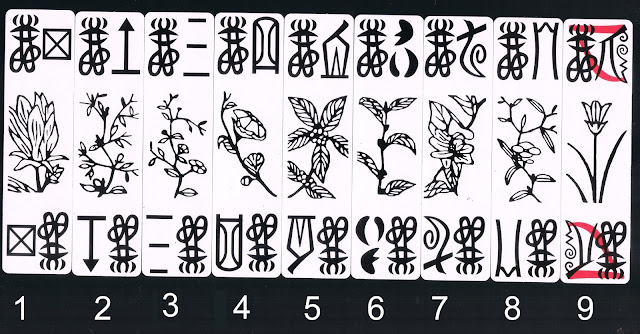華雅麻將, 144c.
Haoya Majiang ("Luxurious Mahjong")144c.
Now, a set of playing-cards with a difference. This is a mahjong set, purchased in 2018 in Singapore. However, The author remembers such sets being produced around the year 2014, which he subsequently lost.
Unlike most mahjong sets, this is not intended for the living. It is rather intended for the dead. This majhong set is an example of "Joss paper", paper objects intended to be burnt as offerings to the ancestors and spirits.
Effort has not been spared in the production of such an ephemeral set. Each "tile" is a small box made of folded card. Becuase they are made of printed paper, the manufacturer can be more creative in designing the tiles.
There are 144 tiles in total, but their distrubution is extremely erratic. A standard set of mahjong tiles has exactly 4 copies of each tile, but in this set, some tiles can have as few as 2 copies and others as many as 6. The exact distribution is as follows:
Rank
Suit
|
1
|
2
|
3
|
4
|
5
|
6
|
7
|
8
|
9
|
萬
Myriads
|
3
|
6
|
2
|
2
|
4
|
5
|
7
|
4
|
2
|
竹
Bamboos
|
2
|
5
|
7
|
3
|
4
|
5
|
5
|
2
|
2
|
筒
Coins
|
6
|
6
|
4
|
3
|
3
|
3
|
5
|
3
|
4
|
Other cards
|
中·
Red Dragon
|
白
White Dragon
|
發
Green Dragon
|
東
East
|
南
South
|
西
West
|
北
North
|
花
Flowers
|
|
|
2
|
9
|
5
|
3
|
4
|
3
|
3
|
8
|
|
|
The Suit of coins. From Right to left, the 1-9 of coins . The furthest tile on the left is the 白板, Bai ban ( lit "White board") conventionally known as the White dragon in English.
Because the tiles are small boxes of printed paper, the manufacturer can make them much fancier than the ordinary sort. Note the small coloured border surrounding each of the tiles-- Engraving such a border on each tile would be prohibitively expensive.
The Suit of Bamboos. From Right to left, the 1-9 of bamboos. The 1 of bamboos is a bird. The furthest tile on the left is the 红中 , Hong Zhong, Literally Red Center, conventionally known as the Red dragon in English.
The 1 of bamboos is depicted as a scarlet Macaw. Compare this with the much more stylized versions found Here and here and Here. Apart from that, the bamboos look much like those on convntional decks
The Suit of Myriads. From Right to left, the 1-9 of myriads
The furthest tile on the left is the 青發, Qing fa, Literally Green prosperity, conventionally known as the green dragon in English.
Top Row: Flowers (1) : L-R Spring, Summer, Autumn and Winter
Middle row - Flowers (2) -- L-R Plum, Orchid, Chrysanthemum, and bamboo
Bottom row: The Winds - L-R East, South, West, North
Most Mahjong sets contain 'Flowers" These are extra tiles, which act as bonuses.The medium of printing offers a further opportunity for elaboration, with gaudy stockart replacing the stylized flowers of ordinary sets.
Note the fancy rainbow effect on the winds. (bottom row). Most sets of mahjong cards (intended for actual use as opposed to an offering) follow the tiles very closely, even though (as we can see here) it is easy for fancy effects to be made in printing. Perhaps because it is precisely because it is an offering, that the makers can get away with making it so gaudy.
The above two images show the box the tiles come in , with and without the lid. Like the tiles themselves, the box is made of paper, and intended to be burnt along with the tiles.
The manufacturer has also provides some paper jetons and a wind indicator, along with a pair of dice (also of paper).
In addition to the mahjong set, a box of playing-cards is provided for the added amusement of the spirits. Alas, the box is empty, and contains no cards.
From the side, it is easy to see how the tiles are constructed-- Small boxes of paper. You can also see the yellow-coloured backs of the tiles. Prior to the invention of plastic, majhong tiles were made of bone laminated to bamboo. The yellow colour represents the bamboo. Plastic tiles also have this feature-- their backs are of a different colour than their faces.































